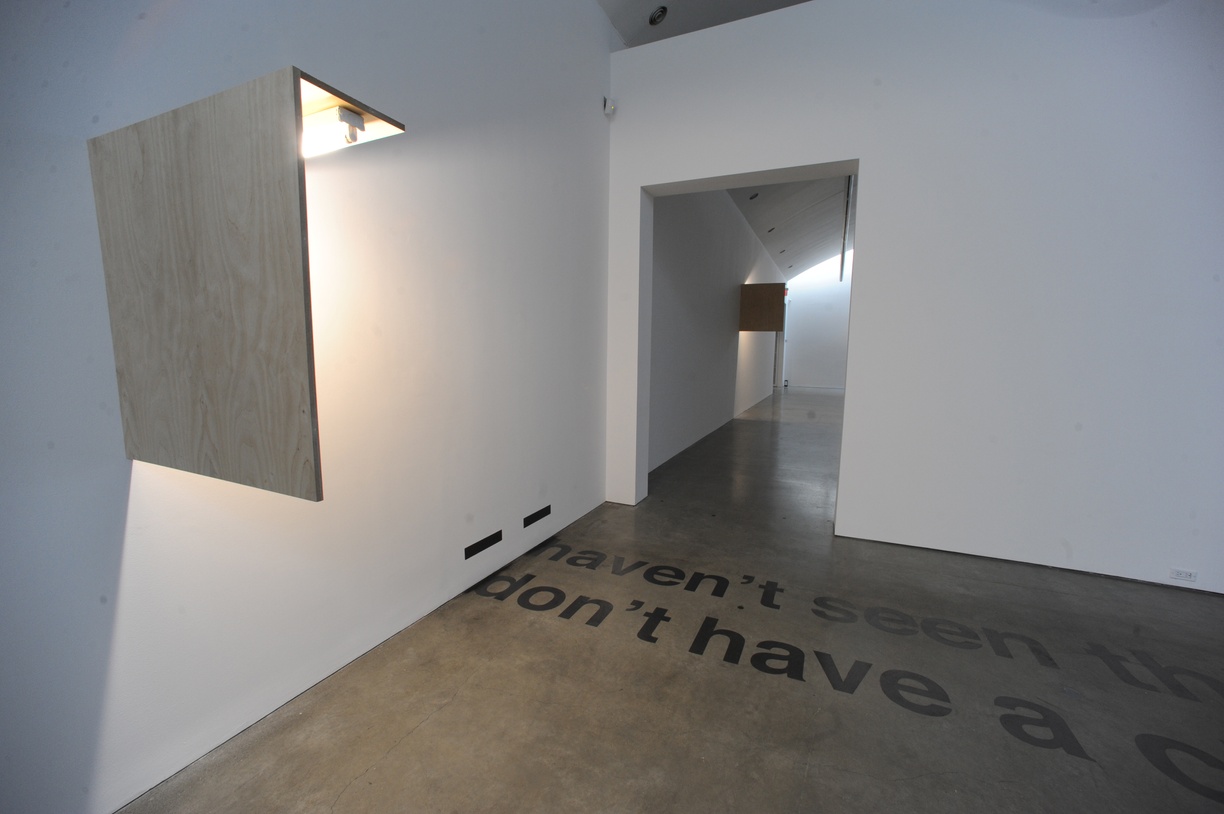
The Center for Curatorial Studies at Bard College (CCS Bard) is proud to present RETROACTIVE , an exhibition of site–specific works by Greek artist Antonis Pittas. This installation adds to the ongoing dialogue explored in his 2010 and 2011 exhibits Untitled (this is a historic opportunity for us) at the Van Abbemuseum in Eindhoven, and shame on you, at the Annet Gelink Gallery in Amsterdam, where Pittas lives and works.
The work in RETROACTIVE draws from a multi-dimensional series of cues offered by the architecture, institutional memory, and discursive space of CCS Bard and presents a platform for considering collective memory in the public sphere.
Pittas acts as a conduit in the development of his large-scale graphite drawings and sculptural objects, porously responding to and appropriating the shifting conditions of his physical site and its surrounding socio-political energies. Traces of the exhibit Blinky Palermo: Retrospective 1964-1977, which previously inhabited the CCS Bard Galleries, are reactivated by Pittas to illuminate the artists’ shared engagement with the nonobjective work of the Russian avant-garde. Otherwise abstract shapes–triangle, circle, and square–are contaminated by allusions to picket signs and graffiti drawn from the Occupy movement, the Arab Spring, and protests in the artist’s hometown of Athens. Such evocative aesthetic and contextual shifts mirror the memes of the current global climate of protest and upheaval. Likewise, texts collected from the public domain and fragments of news stories are promoted from the quotidian to the iconic. Drawn text “Let him go, let him go,” chanted at a recent Oakland demonstration, snakes around the architecture like a paused ticker, toying with the viewer’s perception of time. The result is a sweeping and spare Suprematist composition that posits the physical and ephemeral scars of the city in the memorializing site of the museum.
The mercurial surface of graphite in Pittas’s precisely rendered graphic and text interventions activates the concrete floor and white gallery walls, achieving an optical effect that confuses the mundane and the sublime. The viewer is invited to tread on the floor drawings, dismantling the work by displacing the residue of the graphite, either as a passive or political gesture. This registers a shifting set of conditions for the experience of the exhibit. The malleability of the work dually evokes the fragility of any fixed, subjective relationship to place, and lends authorship to the public, asking what can deconstruction produce? What informs public memory? Can we look to marks left by acts of impulse, hostility, necessity, or incident to provide a more honest reading of the skin of the city? And lastly when does the ephemeral become monumental?
Antonis Pittas is an artist who mainly creates context-sensitive spatial installations, which are informed by architecture, art-historical references, the performative aspects of installation art, and its social dynamics. The majority of his projects come into existence over a longer period of time, and always in relation to a particular site or context. Recent exhibitions were on view at Annet Gelink Gallery in Amsterdam (2011), Kunsthal Charlottenborg in Copenhagen (2011), the Van Abbe Museum in Eindhoven (2010), SMART Project Space in Amsterdam (2009), and Ileana Tounta Contemporary Art Centre in Athens (2008). Next to his art practice Pittas, for the last four years, is a teacher at the Rietveld Academy and the Sandberg Institute in Amsterdam, The Netherlands. Antonis’ full website: http://www.antonispittas.info/
RETROACTIVE was developed during a 2011 residency at CCS Bard in conjunction with discussions and collaborations with CCS Bard students. RETROACTIVE , as well as the residency, was made possible through the generous support of The Netherlands Foundation for Visual Arts, Design and Architecture (Fonds voor Beelende Kunsten Vormgeving En Bouwkunst).
Fonds voor Beelende Kunsten Vormgeving En Bouwkunst (Fonds BKVB)
With the International Studio Program the Fonds BKVB seeks to offer the opportunity to gain fresh or revived inspiration, to improve the artist’s career prospects by linking up with international and local networks, to gain knowledge of other (urban) cultures, a ‘time out’, reflection on one’s own work, on one’s own career and on developments in the (international and Dutch) art world. It is also important that artists are enabled to assess their work in an international context and that their presence abroad contributes to the international discourse. Exploring other cultures is becoming ever more important in a world where ‘identity’ appears to be emphasized - or opposed - on the basis of the notion and interpretation of culture at various levels (national, social, individual). This is why there have been recent expansions of the offering with studios in Cairo, Curaçao, Rome, Istanbul, Surinam and Prague.
The Fonds BKVB has access to artist-in-residence places and studios in New York (ISCP), Annandale-on-Hudson (CCS Bard), Berlin (Künstlerhaus Bethanien and AiR Berlin Alexanderplatz), Paris (Atelier Holsboer), Banff (Center for the Arts, Canada), Rome (Projectstudio at the American Academy), Stockholm (IASPIS), Istanbul (PiST///), Cairo (Townhouse Gallery), Beijing (Projectstudio), Tokyo (AIT), Rio de Janeiro/Sao Paulo (Capacete), Curaçao (IBB), Belgium (WIELS), Prague (Meetfactory), and Moengo,(Tembe Art Studio, Surinam).
The aim of the international studio program is allowing visual artists, designers and architects to work in one of these studios to enable them to develop and reflect upon their work in a different environment and culture. Such a residency also generates opportunities for making or extending international contacts and for exploring and/or developing a new market.








